The brothers were both of medium height with “wheat-coloured” faces and grey-blue eyes. They hailed from Kalkandelen (as the town was known in the Ottoman Empire) and came to Jerusalem to create flour mills and bakeries—and families.
Two unexpected snapshots of sorts, taken in 1905-1906, have added colour and detail to the picture I’ve been building over the years about these two brothers and their families. The younger brother was my great-great-grandfather George Schtakleff; the other, his brother Zacharia.
The vast majority of the stories I’ve collected so far take place in Palestine under the British Mandate with only snippets attached to them about the preceding era. By the time I learnt enough history to focus on the fact that my grandmother had lived all of her pre-teen years in the Ottoman Empire—she was twelve when the Brits conquered Jerusalem in December 1917—it was too late to ask her about it.
These recently received snapshots consist of two pages from the Ottoman census of 1321 (in the Mali, aka Rumi, calendar) or 1905-06 (in the current Gregorian calendar) and thus connect the family story to its Ottoman past. They came courtesy of Michelle Campos, Associate Professor of Jewish Studies and History at PennState (Pennsylvania State University). I knew of her because several years ago her book Ottoman Brothers: Muslims, Christians, and Jews in Early-Twentieth Century Palestine was highly recommended to me by an anthropologist friend. I finally got round to reading it last year and found it fascinating.
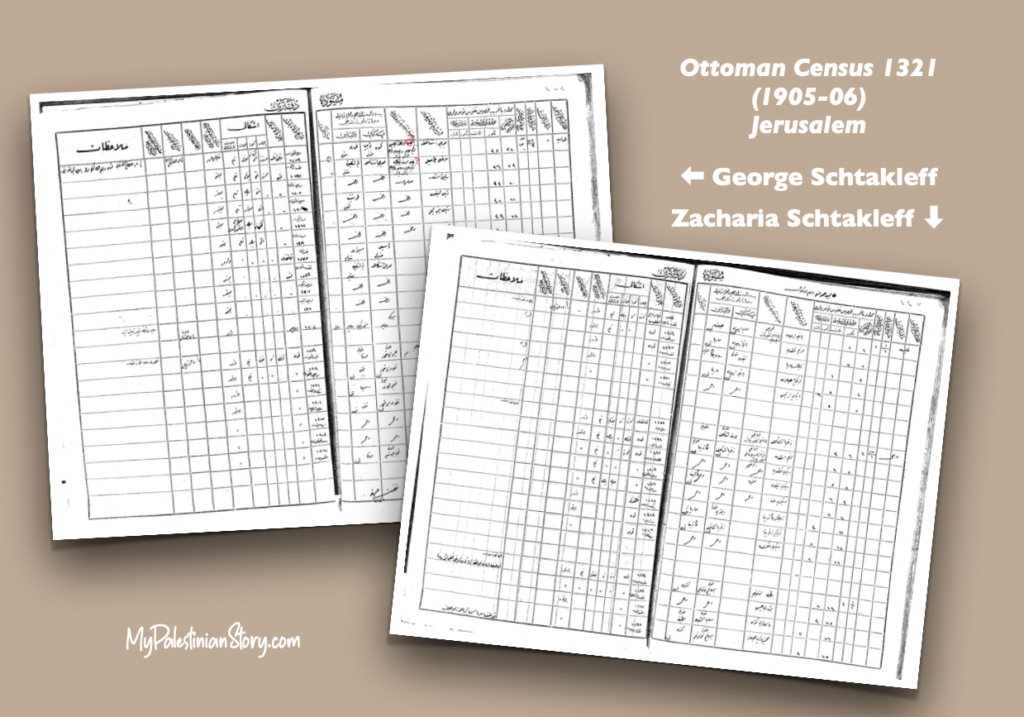
As it so happens, Michelle is a fan of Dorit Naaman’s interactive documentary, Jerusalem, We Are Here (JWRH)—in which I am both a participant and associate producer—and has used it in her classroom over the years. In January 2023 I published a post on the JWRH blog about our map, which prompted Michelle to get in touch with us. She had been working with the data of the Ottoman censuses and wanted to discuss ideas about how to map this data and make it available to the public. Dorit, Michelle and I had a Zoom call during which Michelle kindly offered to look up names for us in the census.
I thought of her offer recently when I came upon an old document I had found years ago in my grandfather’s papers. At the time I thought it was in Arabic, although the sultanic tughra at the top should have clued me in. I included it in a batch of Arabic documents of my grandfather which I took to a Palestinian translator who immediately identified it as Ottoman. But he could make out a name: Vassili Schtakleff—my great-grandfather John’s brother. Not knowing anyone who could read Ottoman Turkish, I set it aside.
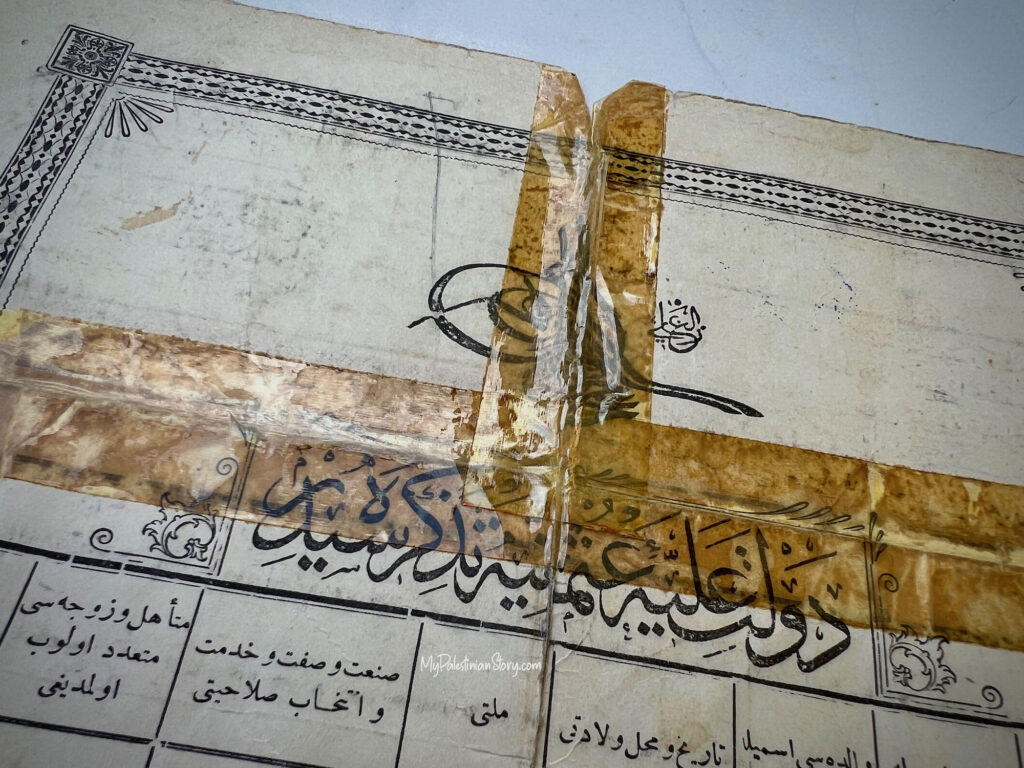
(Marina Parisinou’s archive)
When I came across it again this summer, I thought I could perhaps… abuse Michelle’s generous offer and ask her to translate it since she reads Ottoman. So I added it to my request for the two names I’m primarily interested in in my research, first among them: Schtakleff. (The other is Lorenzo in connection to my Semiramis research but that’s a whole different story.)
I explained to Michelle that in Arabic the name was sometimes spelt with an E at the beginning: Eschtakleff. That’s how it was written in the Register of the Christian Orthodox Community in Holy Jerusalem which I discovered at St James’s chapel next to the Holy Sepulchre in Jerusalem in 2015.
Two days later—the day after my birthday—Michelle emailed me with the translation of the document as well as two pages from the 1321 census—one page on George, the other on Zacharia—adding notes of translation over the fields of the forms. A better birthday present I could not have received!
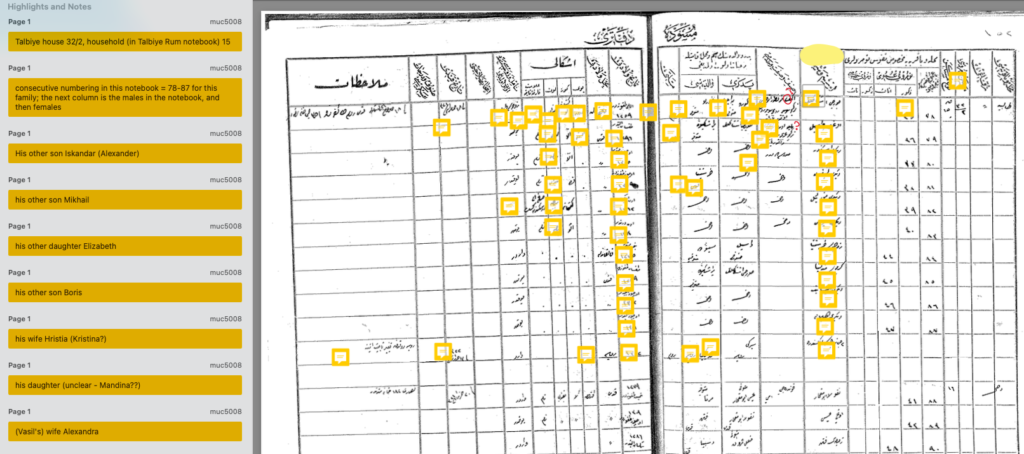
with translation notes by Michelle Campos
Some of the information was confusing. Both George and Zacharia are in the Talbiyeh registers whereas I knew they lived in Mamilla. Michelle explained that the borders of neighbourhoods back then were quite fluid.
The bakery was very close to where the American consulate is (or rather was until 2018). In fact George’s youngest son, Boris, when he visited Jerusalem in 1972, identified the front house (the one that’s right on the street, in front of the main building) at 18 Agron Road, which was then part of the USA consulate, as the house where he had grown up. (All of that is part of the US Embassy now.) Apparently it was sold to the Americans in Ottoman times—1912 according to the US Office of Palestinian Affairs.

(Photo courtesy of Boris’s grandson, Chip Marcin)
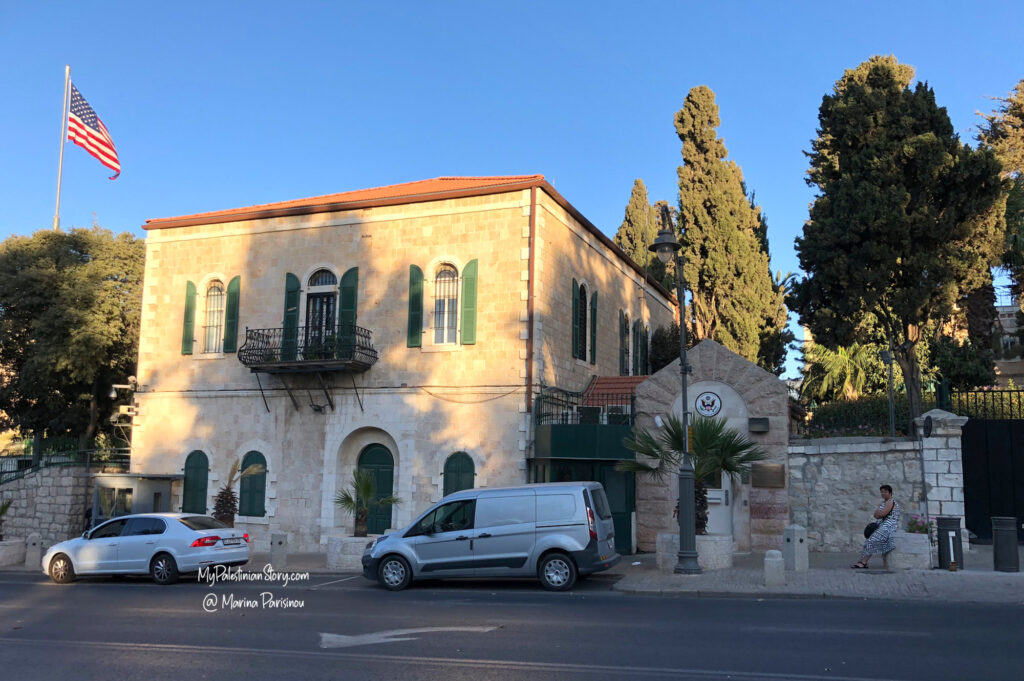
(ie George Schtakleff’s residence in the early 1900s)
(Photo by Marina Parisinou)
Also puzzling was the fact that different names were listed for the father of the two brothers. Michelle again explained the challenges involved in deciphering information recorded by clerks of varying calibre, some of whom were not as diligent or accurate as others.
But beyond that, everything seemed to correspond more or less to the information I’ve had in my records, confirming it and augmenting it. Birthdates, with a few exceptions, were exactly the same as the ones I found in the above-mentioned Register. I wonder if there was a flow of data from one source to the other, ie from the Register to the census or vice-versa.
As I pored over the information in these documents, I felt that in each of the houses these people lived in a wall fell away. I could now look inside them the way one peers at the various rooms of a doll house, the figures made smaller and amenable to observation in this case by the distance of time rather than by scale as in a miniature house.
George Schtakleff
Head of household in one of the houses is George (Jurji) (E)Schtakleff, a “bread merchant” from Tetovo (in today’s Republic of Northern Macedonia) who, as he reports to the census clerks, speaks Turkish and Greek, and reads and writes Russian. I knew that he was in the flour business and supplied the Ottoman army with bread. But he was Bulgarian/Macedonian so I wonder about the Russian. Perhaps that was a catch-all term for Slavic languages written in Cyrillic.
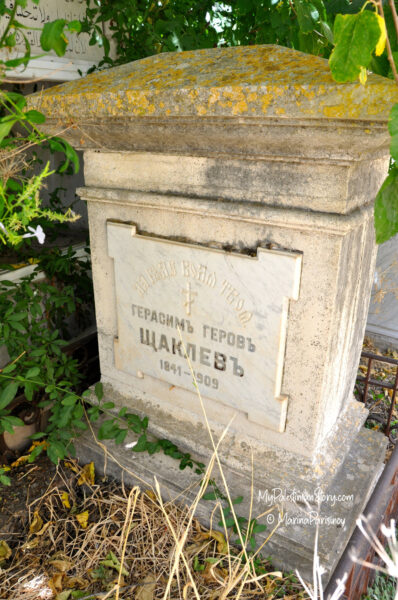
(Photo by Marina Parisinou)
He is in his mid-60s (the census puts him at 62 but according to the date on his grave he would be 65). He is a member of the Rum (ie Greek Orthodox) millet, and all of his children have been born in Jerusalem. Which makes my mother a third-generation Jerusalemite.
With him is his wife, Hristia or Kristina, aged 47. Another name I was given for her was Hadjitsa, which I suspect is the female equivalent of Hadji, a type of nickname or prefix to their surname that Greek Orthodox men gain after visiting the Holy Land (deriving from the same Muslim term for people who have made the hajj to Mecca.) Kristina was the second wife—or at least the second with whom he had children. My grandmother spoke of a very first wife, called Maria, who died before bearing offspring.
Kristina’s predecessor was Paraskevi (as confirmed by the rough transcription of Branskiva or Brashkiva in the census). She was the mother of George’s first six children, five of which we see in this tableau: Vassili, aged 26; Madelaine or Magdalena (23); Elisabeth (20); Alexander, aka Sanco (17) who had his father’s grey-blue eyes; and Helene (16). (The girls’ names were always pronounced in French in the family perhaps because of their French education.) In a few years their dysfunctional relationship with their step-mother will push the last four to convert to Catholicism and leave for Egypt, which will cause George a great deal of pain. This event was described in the family as a “kidnapping” by the Catholics which always puzzled me. In recent years I was able to make some sense of the story which I’ll explain in a later post. But for now I am able to narrow down how old the children were when they left. Since George died in 1909, that leaves a four-year window: 1905-1909.
Vassili’s wife, Alexandra, a Russian aged 19, will join the household (and the census) a year later. In just a couple of years their first daughter, Olga, will arrive followed by her sister Liza.
As for the document with the tughra, it turned out to be an ID which described Vassili as of medium-height, with a white face and greyish-blue eyes—his father’s son. His mother, again, is listed as Parashikua.
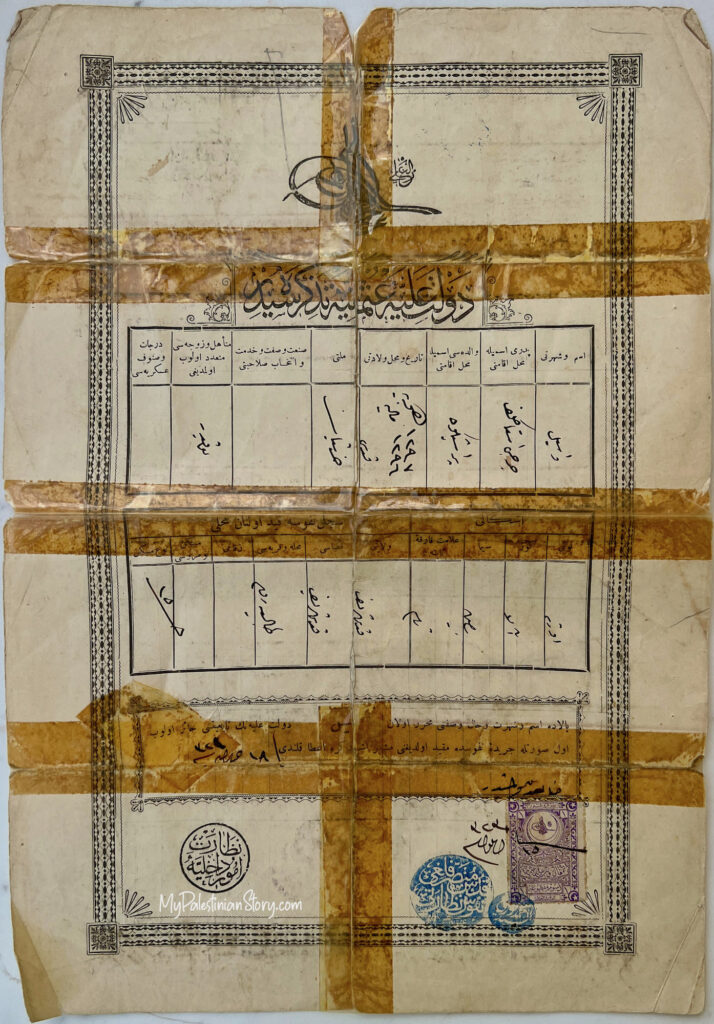

Recto on the left. The verso is patched up with official paper of the Palestine Government (British Mandate): a composite of empires!
(Marina Parisinou’s archive)
There are three more boys in the picture, Kristina’s sons, and the last offspring of George: Grigori/Gregory (the census has badly mangled his name) (13) with black eyes; Mikhail/Michael (10) with chestnut eyes; and grey-blue-eyed Boris (8). I knew of Michael’s existence but was told he died very young, perhaps a few years old. Now I know that he lived at least until he was 10. All the other males in the family are reported as having no handicaps. He is described as having a problem with his elbow or sty in his eye (the script can be very sloppy making it hard at times for Michelle to decipher), perhaps a harbinger of his early demise. The only one I will ever meet of this generation is Boris who visited Cyprus in 1972 when I was a child but I still remember him vividly.

(Photo archive of Michel Stakleff)
Sanco as well as Kristina’s three boys are in school at the time of the census. The two older girls would have graduated but no word on Helene. Perhaps female education was not deemed worthy of mention. It’s only in this census and the one before it (mali year 1299 or 1883/84) that the existence of females was recorded. Prior registrations of different sorts recorded males for tax and conscription purposes.
Later on, in Egypt, Sanco will eventually become Inspector of Arabic Education in the De La Salle Christian Brothers school system and will occasionally travel to Jerusalem to visit his family. Madelaine will become a teacher and at some point teach the children of the King of Egypt. The elusive Helene will become a nun, go to Rome, and be canonised (don’t know if I’ll ever be able to confirm that.) As for Elisabeth, she’ll marry a Frenchman in Cairo and build a large family; and in 2022 I will discover her on a family tree on the internet and spend a good two hours chatting online (read: struggle to hold a conversation with my mediocre French) to her grandson François in France, and learn more of her story.
John Schtakleff
Most notable by his absence from this house is George’s oldest son: my great-grandfather John. He married in 1902 and in March 1905 his first-born, Paraskevi, ie my grandmother Vitsa, had popped into the world. I suggested to Michelle that as such he may have fled the coop and set up his own household.
Sure enough, the following day Michelle sent another page from the census. In 1905-06 Yoan Eshtakleff, ie John Schtakleff, is living in Manshiya, north of Mamilla outside of the New Gate, in the vicinity of the Russian Compound area. He is in his late 20s (again some discrepancy here—the register puts him at 26, the census at 30), tall (I know that from his photos), has chestnut eyes (I thought they were blue) and has a white face which he most certainly bequeathed to my grandmother.
He reads and writes Arabic, Turkish, Russian, French, and Greek—or so he tells the census.
His wife is Eugenie Agathopoulou, 24 years old, a Greek from Istanbul, who caught his eye in one of her performances with her father’s itinerant theatre troupe. And now I finally get a sense of what happened to her parents after her marriage caused the troupe to disband. Anestis is still living in Jerusalem; Rosa has died. And Yiayia Vitsa, born on 14 March 1905, is just a tiny blue-eyed baby!
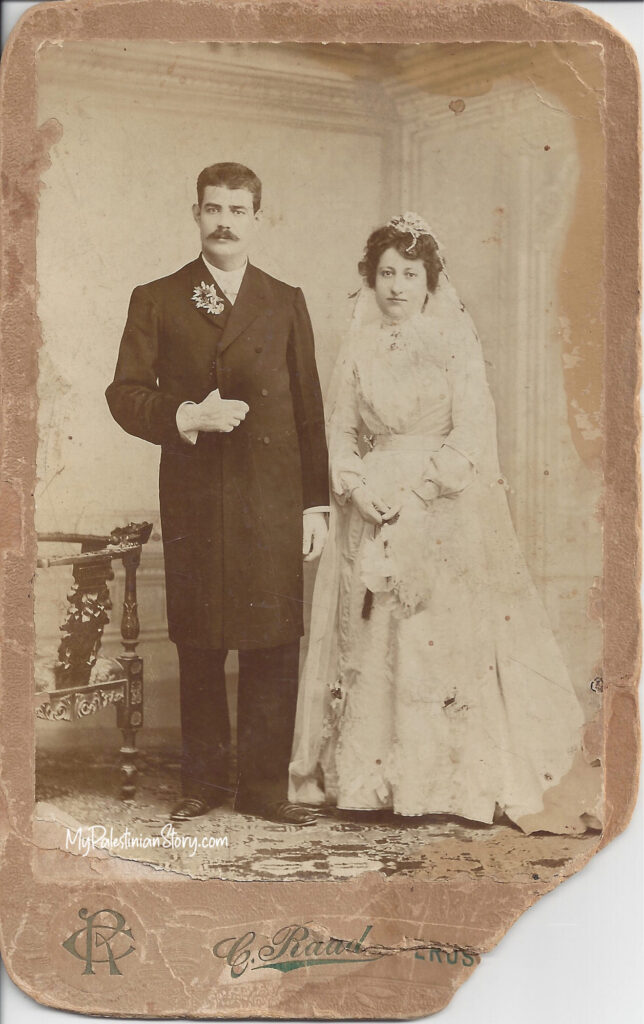
Photograph by Khalil Raad
(Marina Parisinou’s archive)
Zacharia Schtakleff
In another house in what’s listed again as Talbiyeh (but was again Mamilla, to the north) I find George’s elder brother Zacharia with his brood. His stature and colours are the same as his brother’s. But he’s a few years older (67 or 69). He’s a baker (no surprises there) but intriguingly he only reports Greek as the language he reads and writes. That throws me off. My mother used to say that Grandfather John spoke Greek because he married a Greek—Eugenie—and thus mixed with the Greek community and was Hellenised (εξελληνίστηκε). Why would Zacharia know Greek and report it as his only language is mystifying. Frankly, the whole issue of their ethnicity is something that I haven’t been able to get my head around. Were they Macedonians, Bulgarians or even Albanians? George apparently was known in Jerusalem as George l’Arnaout (French pronunciation again) which is how Turks described Albanians. And why are they reporting themselves as Greek speakers but not of a Slavic language? Someday I may get to the bottom of this one…
But for now, it’s 1905-06 and Zacharia is living with his second wife, Catherine (Katarina), who conveniently perhaps for him has the same name as his first one. (But it’s a bit of a nuisance for those of us of his descendants who build family trees and collect stories and need to make distinctions: we have to resort to the dynastic-sounding Catherine I and Catherine II.) Katarina Kirchieff—or the second Catherine—also hails from Tetovo. She is aged 37 and is the daughter of Dimitri who has died and of Maria who is in Skopje. All their children were born in Jerusalem and the boys are white. The girls’ appearance seems to be inconsequential—or immodest to mention—for the census.
Living in the same house are Zacharia’s two sons from the first Catherine: Stephan and Constantine. There is quite a discrepancy in their birth years from what the Register shows (Stephan b 1872, Constantine, b 1876) and what the census reports (Stephan b 1880/81, Costantine b 1881/82). But both are in the family business—Stephan a baker, Constantine a miller—and both read and write French and Greek.
It doesn’t surprise me that they’re still living at home. They’re both single but only for a few months more. At some point in 1905 they will both marry Tetovo women and start their own families. And more than a hundred years later, in 2018 I will have the good fortune to meet Stephan’s last remaining offspring, his son Michel (Feb 1922-Apr 2021) and spend a few memorable days with him in Florida talking family history.
The brothers’ half-siblings—Catherine II’s children—have all been born save the last one, Marika, who will make her appearance in 1907. At home now we find Nicola (13), Zacharena (9), blue-eyed Hanna (John) (6) and Alexandra (4). The boys are in school. Once again, we don’t know about the girls, but they too must have been— at least Zacharena. She is more than 20 years away from her marriage to well-known Palestinian photographer Daoud Abdo. And incidentally as I write this I’m only a couple of weeks away from meeting for the first time their son Saba in Beirut for even more family stories.
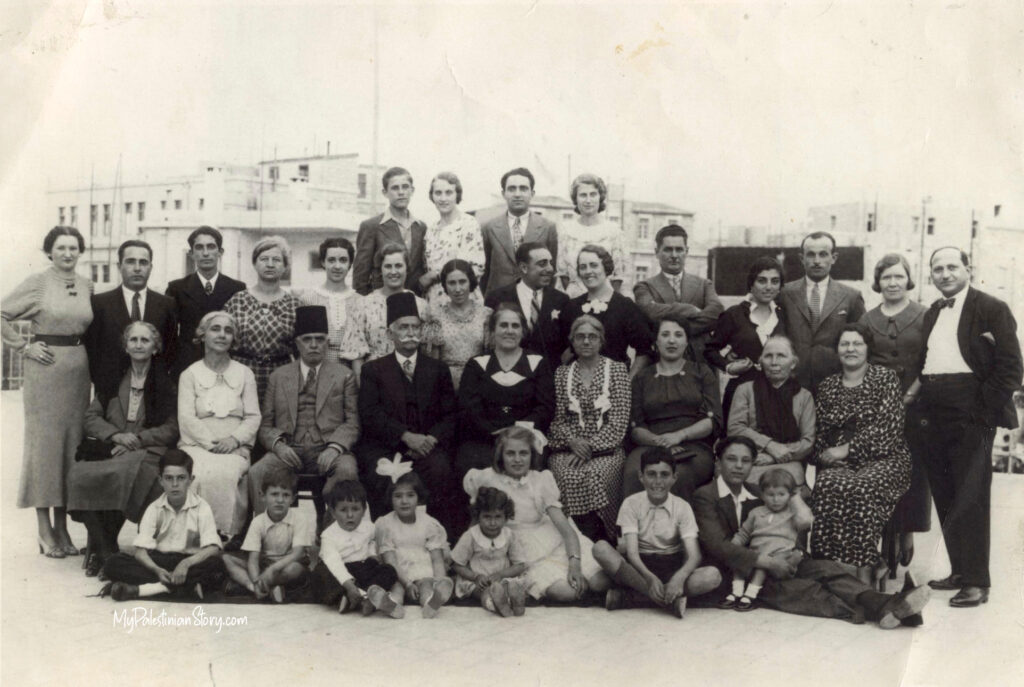
The two seated men with tarbushes are Stephan (R) and Constantine (L).
Daoud Abdo at far right with wife Zacharena seated to his right.
Michel standing at the back row, on the left.
(Photo courtesy of Elias Schtakleff, Constantine’s grandson)
It never ceases to amaze me how pieces of paper, simple documents—digitalised or raw—can tell such vivid stories. I’m grateful to Michelle Campos for gifting me these ones.
I am happy to share these documents with the extended Schtakleff clan. If you’re on my family tree, you may feel free to ask! ❖
_______________________
References:
- Placing Jerusalemites in the History of Jerusalem: The Ottoman Census (sicil-i nüfūs) as a Historical Source by Michelle Campos
https://www.researchgate.net/publication/327008701_Placing_Jerusalemites_in_the_History_of_Jerusalem_The_Ottoman_Census_sicil-i_nufus_as_a_Historical_Source

Hi Marina – I read your fantastic entry to Mum – and she loved it as did I – she mentions to your query :”…Bulgarians or even Albanians? George apparently was known in Jerusalem as George l’Arnaout (French pronunciation again) which is how Turks described Albanians. And why are they reporting themselves as Greek speakers but not of a Slavic language? Someday I may get to the bottom of this one…”. that perhaps it was that Albania had many Greeks making Greek a lingua franca ?…as was the case with Constantinople (Istanbul) where Yiayia Eugenie came from. But definitely worth the research as it is an interesting observation . All that said – we are very, very excited for your next entry and follow up to this incredible family story- sending you lots of love & hugs from Montréal Qc xoxox Corinna
Many thanks, Corinna and Feely! I realise that Greek was lingua franca in the Balkans back then but our lot were (supposedly) ethnic Bulgarians/Macedonians but reported no such language. Yiayia Eugenie was an ethnic Greek so that makes sense. Sooner or later I’ll get to the bottom of it! Again, much appreciate your support!
What a fascinating family history. It certainly is the product of very diligent work, research and of course personal contacts to piece it together. Let me assure you, it was worth every effort you put to untangle all the knots that presented themselves throughout your massive efforts. At a young age in pre 1948, I always wondered as to where from did the Schtakleff name come to exist in Jerusalem. Your article has now, at age 88, provided me with the answer, a wonderful historic one for which I thank you very much.
It certainly was worth it, Tony. And it’s very gratifying having my work appreciated. Many thanks!
lovely
Thank you!
Hi marina ,I read the article is very interesting
One day I would like to search my fathers side of family that came Jerusalem I think in the early twenties from ismirni
Thank you, Eleni!
Thank you for writing this article on the Schtakleff family lineage Marina! This is the first time I have seen a picture of my Great Grandfather Constantine. Do you know if his son George is in this photo as well?
My pleasure, Rurik. Your grandfather George is the one in the top row, between the two girls (Zorka and Louba). I’ll soon share a very valuable document with your and your family which I know you’ll love. Stay tuned 😉
What an amazing compilation of family history! Brava, Marina! You are such a careful researcher and a wonderful chronicler of the Schtakleff family in Jerusalem!
Many thanks, Mon!
Thank you Marina. My great my grandmother was Victoria Zacharia -Greek orthodox Christian- and Victoria’s father , George Zacharia was born at roughly 1880 the judge ottoman at Jerusalem.
Her Victoria,s husband was judge supreme judge from Jerusalem -British mandate-he was born at 1900 and R.I.P 1964.
Hanania Hanania and Victoria Zacharia had cousins who were Greek who moved to Athens in the 1960s.
Are there Zacharia or Hanania were Greek before?
Thank you
Thanks for writing, Ellen. I’m afraid I don’t know much about the Hananias although at some point I was given a photos of my great=grandparents’ wedding that came from a Hanania so the familys must have been friendly.